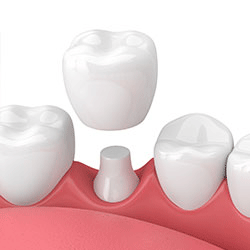Crowns & Fillings

Crowns are a cosmetic restoration used to strengthen a tooth or improve its shape. Crowns are most often used for teeth that are broken, worn, or partially destroyed by tooth decay.
Crowns are “cemented” onto an existing tooth and fully cover the portion of your tooth above the gum line. In effect, the crown becomes your tooth’s new outer surface.
Crowns can be made of porcelain, metal, or both. Porcelain crowns are most often preferred because they mimic the translucency of natural teeth and are very strong.
Crowns or onlays (partial crowns) are needed when there is insufficient tooth strength to hold a filling. Unlike fillings, which apply the restorative material directly into your mouth, a crown is fabricated away from your mouth. Your crown is created in a lab from your unique tooth impression which allows a dental laboratory technician to examine all aspects of your bite and jaw movements.
Your crown is then sculpted just for you so your bite and jaw movements function normally once the crown is placed.
Traditional dental restoratives, or fillings, include gold, porcelain, and composite. The strength and durability of traditional dental materials make them useful for situations where restored teeth must withstand extreme forces that result from chewing, such as in the back of the mouth.
Newer dental fillings include ceramic and plastic compounds that mimic the appearance of natural teeth. These compounds, often called composite resins, are usually used on the front teeth where a natural appearance is important, but they can also be used on the back teeth depending on the location and extent of the tooth decay.
What's right for me?
Several factors influence the performance, durability, longevity, and expense of dental restorations, including:
- The components used in the filling material
- The amount of remaining tooth structure
- Where and how the filling is placed
- The chewing load the tooth will have to bear
- The length and number of visits needed to prepare and adjust the restored tooth
Before your treatment begins, we will discuss with you all your options and help you choose the best filling for your particular case. In preparation for this discussion, it may be helpful to understand the two basic types of dental fillings — direct and indirect.
- Direct fillings are placed immediately into a prepared cavity during a single visit. They include glass ionomers, resin ionomers, and composite (resin) fillings. A dentist prepares the tooth, places the filling, and adjusts it in one appointment.
- Indirect fillings generally require two or more visits. They include inlays, onlays, veneers, crowns, and bridges fabricated with gold, base metal alloys, ceramics, or composites. During the first visit, the dentist prepares the tooth and makes an impression of the area to be restored. The dentist places a temporary covering over the prepared tooth. The impression is sent to a dental laboratory, which creates the dental restoration. At the next appointment, the dentist cements the restoration into the prepared cavity and adjusts it as needed.



 Website Powered by Sesame 24-7™
Website Powered by Sesame 24-7™